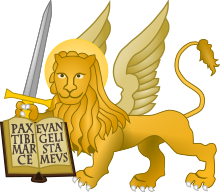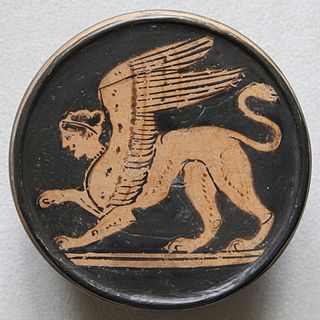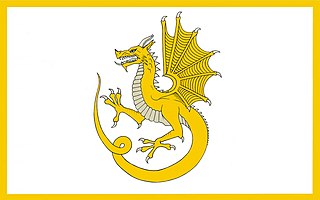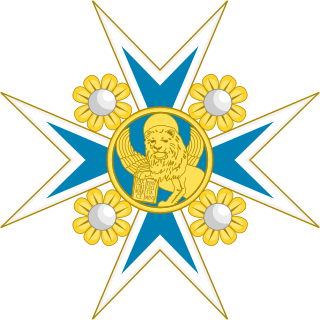
The winged lion is a mythological creature that resembles a lion with bird-like wings.

The winged lion is a mythological creature that resembles a lion with bird-like wings.
The winged lion is found in various forms especially in ancient and medieval civilizations.
There were different mythological adaptions for the winged lion:

The emblems of the winged lions were featured in different countries:

A sphinx is a mythical creature with the head of a human, the body of a lion, and the wings of an eagle.

According to Greek mythology, the Chimera, Chimaera, or Chimæra was a monstrous fire-breathing hybrid creature from Lycia, Asia Minor, composed of different animal parts. It is usually depicted as a lion, with the head of a goat protruding from its back, occasionally depicted with dragon's wings, and a tail that might end with a snake's head. It was an offspring of Typhon and Echidna and a sibling of monsters like Cerberus and the Lernaean Hydra.

The wyvern is a type of mythical dragon with two legs, two wings, and often a pointed tail which is said to be a venomous stinger.

A tetramorph is a symbolic arrangement of four differing elements, or the combination of four disparate elements in one unit. The term is derived from the Greek tetra, meaning four, and morph, shape.

Lama, Lamma, or Lamassu is an Assyrian protective deity.

Anzû, also known as dZû and Imdugud, is a monster in several Mesopotamian religions. He was conceived by the pure waters of the Abzu and the wide Earth, or as son of Siris. Anzû was depicted as a massive bird who can breathe fire and water, although Anzû is alternately depicted as a lion-headed eagle.

In heraldry, a charge is any emblem or device occupying the field of an escutcheon (shield). That may be a geometric design or a symbolic representation of a person, animal, plant, object, building, or other device. In French blazon, the ordinaries are called pièces, and other charges are called meubles.

Pixiu is a Chinese mythical hybrid creature. Pixiu are considered powerful protectors of the souls of the dead, xian, and feng shui practitioners, and resemble strong, winged lions. A Pixiu is an earth and sea variation, particularly an influential and auspicious creature for wealth, and is said to have a voracious appetite exclusively for gold, silver, and jewels. Therefore, traditionally to the Chinese, Pixiu have always been regarded as auspicious creatures that possessed mystical powers capable of drawing cai qi from all directions, and according to the Chinese zodiac, it is especially helpful for those who are going through a bad year.

The eagle is used in heraldry as a charge, as a supporter, and as a crest. Heraldic eagles can be found throughout world history like in the Achaemenid Empire or in the present Republic of Indonesia. The European post-classical symbolism of the heraldic eagle is connected with the Roman Empire on one hand, and with Saint John the Evangelist on the other.

The National Emblem of Iran since the Iranian Revolution features four curves and a sword, surmounted by a shadda. It is very similar to the Sikh Khanda symbol. The emblem was designed by Hamid Nadimi, and was officially approved by Ayatollah Ruhollah Khomeini, the first supreme leader of Iran, on 9 May 1980.

The lion is a common charge in heraldry. It traditionally symbolises courage, nobility, royalty, strength, stateliness and valour, because historically the lion has been regarded as the "king of beasts". The lion also carries Judeo-Christian symbolism. The Lion of Judah stands in the coat of arms of Jerusalem. Similar-looking lions can be found elsewhere, such as in the coat of arms of the Swedish royal House of Bjelbo, from there in turn derived into the coat of arms of Finland, formerly belonging to Sweden.

The national emblem of Thailand is called the พระครุฑพ่าห์. The Garuda was officially adopted as the national emblem by Vajiravudh in 1911. However, the mythical creature had been used as a symbol of royalty in Thailand for centuries. The Garuda is depicted on seals, which are used by the King and the Government of Thailand to authenticate official documents and as its primary emblem.

The lion has been an important symbol to humans for tens of thousands of years. The earliest graphic representations feature lions as organized hunters with great strength, strategies, and skills. In later depictions of human cultural ceremonies, lions were often used symbolically and may have played significant roles in magic, as deities or close association with deities, and served as intermediaries and clan identities.

The griffin, griffon, or gryphon is a legendary creature with the body, tail, and back legs of a lion, and the head and wings of an eagle with its talons on the front legs.

Tibetan mythology refers to the traditional as well as the religious stories that have been passed down by the Tibetan people. Tibetan mythology consists mainly of national mythology stemming from the Tibetan culture as well as religious mythology from both Tibetan Buddhism and Bön Religion. These myths are often passed down orally, through rituals or through traditional art like sculptures or cave paintings. They also feature a variety of different creatures ranging from gods to spirits to monsters play a significant role in Tibetan mythology with some of these myths have broken into mainstream Western media, with the most notable one being the Abominable Snowman – the Yeti.

The Lion of Saint Mark, representing Mark the Evangelist, pictured in the form of a winged lion, is an aspect of the Tetramorph. On the pinnacle of St Mark's Cathedral he is depicted as holding a Bible, and surmounting a golden lion which is the symbol of the city of Venice and formerly of the Venetian Republic.

The Order of Saint Mark was the sole order of chivalry of the Republic of Venice. It was named in honour of Venice's patron saint, Mark the Evangelist.

The Flag of the Republic of Venice, commonly known as the Banner or Standard of Saint Mark, was the symbol of the Republic of Venice, until its dissolution in 1797.
![]() Media related to Winged lions at Wikimedia Commons
Media related to Winged lions at Wikimedia Commons